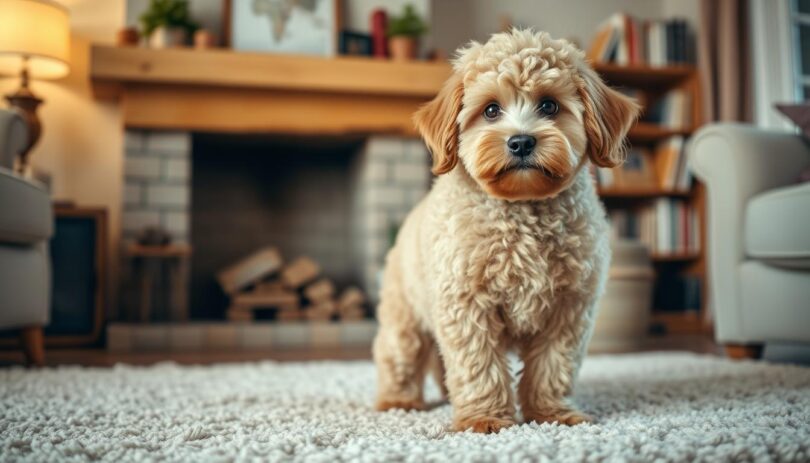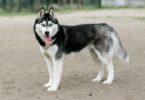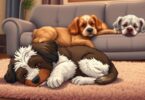What if you could find a family pet that’s both gentle enough for kids and hypoallergenic for sensitive households? Meet the designer dog stealing hearts across America—a fluffy giant bred to combine brains, loyalty, and allergy-friendly fur.
This cross between a Newfoundland and a poodle brings together the best traits of both breeds. Think of a playful, intelligent companion with the calm demeanor of a gentle giant. Their wavy or curly coat sheds minimally, making them ideal for homes where allergies are a concern.
Standing up to 30 inches tall, these dogs rank among the largest doodle mixes. But don’t let their size fool you—their affectionate nature shines through. Families love their adaptability, whether snuggling on the couch or joining outdoor adventures.
In this guide, you’ll discover why this puppy thrives in active households. We’ll break down grooming tips, training strategies, and care routines backed by expert insights. Ready to learn what makes this breed a standout choice for pet owners?
Introducing the Newfypoo: A Unique Designer Dog Breed
Imagine a loyal companion blending the strength of historic working dogs with the brains of show-stopping performers. This crossbreed emerged in the 1990s as part of the doodle craze, combining Newfoundland’s rugged endurance with poodle ingenuity. Breeders aimed to create a family-friendly giant with allergy-friendly fur—a mission that succeeded beyond expectations.
Breed Origins and Hybrid Appeal
The Newfypoo’s lineage reads like a best-of-both-worlds story. Newfoundlands brought their legendary water rescue skills and calm demeanor to the mix. Poodles contributed their famously low-shedding coats and problem-solving intelligence. Together, these breeds form a dog built for modern life—adaptable enough for city apartments yet sturdy for outdoor adventures.
Why This Designer Dog Stands Out
While many doodle mixes exist, this hybrid offers distinct advantages. The poodle parent’s influence creates a hypoallergenic coat that sheds less than most large breeds. Meanwhile, the Newfoundland heritage shines through in their patient, protective temperament. Families appreciate their Teddy Bear appearance paired with a personality that balances playfulness with gentle restraint.
What truly sets these dogs apart? Their ability to switch from couch cuddles to hiking companion mode effortlessly. Unlike smaller designer breeds, they bring substantial size without sacrificing approachability—a rare combination that’s winning over pet owners nationwide.
History of the Newfoundland and Poodle Lineage
The story behind every great dog breed begins with its ancestors’ remarkable journeys. Two working-class heroes shaped the Newfypoo’s DNA—one bred for icy waters, the other for marshlands.
From Fishermen’s Helpers to Hunting Companions
Newfoundlands earned their keep alongside 18th-century fishermen. These powerful swimmers hauled nets through Atlantic waves and rescued drowning sailors. Their webbed paws and waterproof double coat made them indispensable in harsh maritime conditions.
Poodles trace their roots to medieval Germany, where hunters valued their agility. Originally called Pudelhund (splash dog), they retrieved waterfowl from lakes. Their curly fur evolved to protect joints in cold water while allowing swift movement.
Both parent breeds passed down survival skills. The Newfoundland’s calm courage surfaces in the Newfypoo’s patient nature. Poodle intelligence shines through problem-solving abilities. Together, they create a dog breed ready for modern challenges—whether retrieving toys or learning new commands.
This hybrid inherits more than just traits. The Newfoundland’s loyalty and the poodle’s adaptability form a perfect balance. Families gain a companion shaped by centuries of purposeful breeding.
Understanding the Newfypoo’s Unique Physical Traits
The Newfypoo’s stature combines strength and gentleness in one impressive package. These dogs typically stand 22-30 inches tall at the shoulder, with weights ranging from 65 to 150 pounds. Their size varies depending on which parent breed’s genes dominate, creating a spectrum from sturdy to massive builds.
Size, Structure, and Distinctive Features
Newfoundland ancestry gives most Newfypoos a muscular frame built for endurance. Broad shoulders and a deep chest allow powerful movement, while their thick legs provide stability. Despite their substantial weight, these dogs move with surprising grace due to poodle-influenced proportions.
Distinctive facial features enhance their charming appearance. A wide head with expressive eyes sits atop a robust neck, creating that signature “gentle giant” look. Their coat texture varies—some inherit the poodle’s tight curls, others the Newfoundland’s wavy fur—but all versions contribute to their teddy bear appeal.
This hybrid’s physical traits make it both a protective companion and an affectionate family member. The strong build allows them to play gently with children while remaining alert to potential dangers. Understanding their structure helps owners plan appropriate exercise—daily walks suit their endurance, while swimming taps into their water-loving heritage.
When considering these animals, remember their size impacts living arrangements. A 100-pound dog needs space to stretch out, though their calm nature adapts well to various homes. Regular vet checks ensure their large frame stays healthy through every life stage.
Exploring the Newfypoo’s Colorful Coat and Grooming Needs
A dog’s coat tells a story of its heritage and care needs. These hybrids inherit either wavy or curly fur from their poodle lineage, with textures ranging from loose waves to tight spirals. Their dense, soft coats come in shades like black, brown, and gray—sometimes mixed with white patches for a striking appearance.
Coat Types: Wavy or Curly?
Wavy coats resemble the Newfoundland’s water-resistant fur but with softer texture. Curly varieties mirror the poodle’s signature tight coils. Both types shed minimally, making them ideal for allergy-prone households. Regular brushing prevents mats—three weekly sessions work best for most dogs.
Grooming Tips for a Pristine Look
Start with a slicker brush to detangle without pulling hair. Trim nails monthly and clean ears weekly to prevent infections. Professional groomers recommend haircuts every six weeks to maintain shape and manage shedding.
Though hypoallergenic, these coats demand consistency. Home brushing handles surface maintenance, but deep cleaning requires expert care. Invest in quality shampoo to preserve natural oils while keeping fur fresh between salon visits.
Deciphering the Newfypoo’s Temperament and Personality
Understanding a dog's true nature goes beyond its appearance—enter the Newfypoo’s heartwarming temperament. This breed combines the Newfoundland’s nurturing instincts with the poodle’s lively charm, creating a personality that thrives in family settings. Owners often describe these gentle giants as furry therapists, intuitively sensing when their humans need comfort.
Affectionate and Gentle Giants
Stability defines this hybrid’s temperament. Their calm demeanor makes them patient playmates for children, while their affectionate nature ensures constant companionship. Unlike high-strung breeds, they maintain emotional equilibrium even in chaotic households.
Data shows their personality leans toward gentle interactions rather than dominance. They’ll nudge your hand for pets but respect personal space when needed. This balance makes them ideal for first-time dog owners seeking low-drama pets.
Social and Protective Characteristics
Proper socialization unlocks their friendly side. These dogs greet strangers with cautious curiosity rather than aggression. Early exposure to diverse environments helps them distinguish between normal activities and genuine threats.
Their protective instincts emerge as quiet vigilance. You’ll notice them positioning themselves between family members and unfamiliar situations. Yet they rarely bark unnecessarily, offering security without the nuisance factor common in guard breeds.
How Newfypoos Get Along With Kids and Other Animals
Families considering a large, affectionate dog often wonder about compatibility with young members and existing pets. These hybrids excel in both roles when given proper guidance, combining their natural gentleness with adaptable social skills.
Family Compatibility and Child Safety
Their tolerant temperament makes these dogs excellent companions for children. Early socialization helps puppies learn appropriate play behaviors around kids. Teach children to approach calmly and avoid sudden movements during interactions.
Supervision remains crucial due to the breed's size—even accidental bumps from a 100-pound dog could knock over toddlers. Establish clear boundaries for both kids and pets, like designated play areas. Consistent training ensures gentle interactions grow into lasting bonds.
Interactions With Other Pets
Their calm nature helps these hybrids get along with cats and smaller dogs when introduced properly. Start with controlled meetings on neutral ground, using leashes for initial safety. Reward calm behavior with treats to reinforce positive associations.
Multi-pet households should maintain separate feeding zones initially. Monitor play sessions until trust develops naturally. Most owners find their Newfypoo becomes the peacekeeper of the animal group, using body language rather than aggression to communicate.
Newfypoo Energy Levels and Exercise Requirements
Keeping a large, active dog engaged requires strategic planning. These hybrids thrive when their exercise routines match their medium-to-high energy levels. Daily movement isn’t optional—it’s essential for their physical health and emotional balance.
Daily Walks and Active Play Sessions
Start with 60 minutes of brisk walking split into two sessions. Morning and evening strolls prevent restlessness while maintaining muscle tone. Add 20-minute play sessions using toys like frisbees or floating retrievers for water-loving dogs.
Swimming sessions tap into their Newfoundland heritage. Lakes or pools let them burn energy while protecting joints. Always supervise water activities—their enthusiasm sometimes outweighs their stamina.
Consistency matters. Create a schedule mixing walks, fetch games, and mental challenges. Puzzle feeders during downtime keep brains busy. Rotate activities weekly to avoid boredom.
Proper exercise prevents destructive behaviors in high-energy dogs. A tired pet is a happy pet—especially ones weighing over 100 pounds. Tailor routines to your dog’s age, with puppies needing shorter bursts and adults requiring sustained activity.
Owners should monitor energy levels after play. Panting should ease within 15 minutes of resting. Adjust intensity if your dog seems overly fatigued. Balance is key to maintaining their zest for life without overtaxing their large frames.
Training Your Newfypoo: Tips for Success
Training success begins with understanding your dog’s learning style. These intelligent hybrids thrive when owners combine consistency with creativity. Early sessions establish trust while shaping desirable behaviors through clear communication.
Positive Reinforcement and Structured Commands
Start with short 5-10 minute sessions using high-value treats and verbal praise. Reward desired actions immediately—like sitting calmly when greeting people. Avoid harsh corrections; instead, redirect unwanted behaviors with firm “no” followed by a demonstrated alternative.
Teach foundational commands first: “sit,” “stay,” and “leave it.” Use hand signals alongside verbal cues for better retention. Advanced training can include fun tricks like fetching specific toys by name. Always end sessions on a positive note to keep your puppy engaged.
Socialization Strategies for a Well-Behaved Dog
Expose puppies to diverse experiences between 8-16 weeks. Introduce them to various surfaces, sounds, and friendly strangers. Arrange playdates with vaccinated dogs to practice polite interactions.
Practice leash manners during neighborhood walks. Let your dog observe bustling environments from a distance before approaching. Carry treats to reward calm responses to stimuli like bicycles or loud trucks. Consistent socialization builds confidence and prevents fear-based reactions.
Training strengthens the human-canine bond while channeling the breed’s intelligence productively. Pair structured lessons with playful challenges to keep these quick learners motivated. Remember—every interaction teaches something, so make each moment count.
Intelligence and Mental Stimulation for Newfypoos
A brilliant mind thrives when challenged—this hybrid’s cognitive abilities demand creative engagement. Inheriting problem-solving skills from poodles and focused determination from Newfoundlands, these dogs excel when given tasks that blend physical activity with mental puzzles. Without proper stimulation, their sharp intellect can lead to boredom-induced mischief like chewing or digging.
Enriching Activities to Keep Them Sharp
Puzzle toys transform mealtime into brain games. Try treat-dispensing cubes or hide kibble in snuffle mats to engage their natural foraging instincts. Scent work exercises tap into their tracking abilities—hide aromatic treats around your yard and let them sniff out rewards.
Obedience training sessions double as mental workouts. Teach advanced commands like “place” or “wait” using positive reinforcement. Rotate tricks weekly to maintain interest and reinforce learning pathways.
Games and Dog Sports They Enjoy
Agility courses provide physical exercise while testing decision-making skills. Set up homemade hurdles using broomsticks or cones in your backyard. Combine jumps with directional commands to create dynamic challenges.
Interactive fetch games boost both body and mind. Throw a ball, then shout “left” or “right” as they retrieve it. For water-loving dogs, floating toys paired with retrieval commands offer stimulating swim sessions.
Consistent mental engagement prevents destructive habits and strengthens your bond. Mix up activities daily—their eager-to-please nature thrives on variety. A stimulated Newfypoo becomes a content companion, ready to tackle any challenge you present.
Are Newfypoos Good Watchdogs and Service Dogs?
These gentle giants walk a fascinating line between protector and helper. Their Newfoundland heritage gives them a natural alertness to unusual activity, while their poodle lineage contributes calm problem-solving skills. This combination allows them to excel in dual roles when properly trained.
Protective Instincts vs. Gentle Demeanor
Newfypoos often notice strangers approaching before their owners do. They'll typically stand between their family and unfamiliar people, watching intently without aggression. This makes them excellent alert dogs rather than traditional guard dogs.
Their temperament shines in service roles requiring steady companionship. Many assist as therapy dogs in hospitals or schools due to their patient nature. They can retrieve items for people with mobility challenges, using their size advantageously while maintaining gentle control.
Training determines how these traits develop. Early socialization teaches them to distinguish between normal visitors and genuine threats. Consistent reinforcement helps channel their protective streak into appropriate responses. Service roles require specialized instruction to hone their natural intelligence into specific tasks.
Families appreciate this balance of vigilance and composure. While they won't attack intruders, their presence alone deters unwanted activity. For households needing both companionship and subtle security, these dogs offer a unique solution.
Health Considerations for the Newfypoo
Every dog deserves a strong foundation for lifelong wellness. While generally healthy, these hybrids may inherit conditions from both parent breeds. Proactive care helps owners address potential issues before they impact quality of life.
Common Health Issues to Watch For
Eye conditions like progressive retinal atrophy and cherry eye rank among top concerns. Hip dysplasia appears in some lines due to the breed's large size. Heart murmurs and valve issues occasionally develop, requiring early detection through vet screenings.
Mixed-breed dogs can inherit risks from either genetic pool. Watch for limping, excessive eye discharge, or labored breathing. These signs warrant immediate veterinary attention.
Preventive Care and Regular Check-Ups
Bi-annual vet visits catch problems early. Bloodwork and joint exams help monitor breed-specific risks. Many owners add glucosamine supplements to support hip health.
Maintain a lean weight through portion control and exercise. High-quality diets with omega fatty acids promote coat and eye health. Document any behavioral changes—they often signal underlying issues needing professional care.
Feeding and Nutrition for a Healthy Newfypoo
Proper nutrition forms the cornerstone of every thriving pet’s life. For this hybrid dog breed, tailored meal plans support their active lifestyle while preventing weight-related health issues. The right balance of proteins, fats, and nutrients keeps their energy steady and joints strong.
Choosing the Right Diet
High-quality dog food with real meat as the first ingredient meets their protein needs. Active adults benefit from formulas containing glucosamine and omega-3 fatty acids to support joint health. Puppies require calcium-rich meals for bone development, while seniors thrive on lower-calorie options.
Portion sizes depend on weight and activity level. A 100-pound pet may need 4–5 cups daily, split into two meals. Use a measuring cup to avoid overfeeding—obesity strains their large frame. Consult your vet to adjust portions during growth phases or seasonal activity changes.
Supplements like fish oil enhance coat health but should only be added with professional guidance. Avoid fillers like corn or soy, which offer little nutritional value. Fresh water access is non-negotiable, especially after exercise or outdoor play.
Annual vet check-ups ensure dietary choices align with your dog’s evolving needs. Families committed to preventive care often see their companions enjoy longer, more vibrant lives. Remember: what goes into the bowl directly impacts your pet’s vitality and longevity.
Caring for Your Newfypoo: Daily and Seasonal Routines
Creating a structured routine helps these gentle giants thrive while keeping households running smoothly. Consistency in care supports their physical health and emotional well-being, adapting to both daily needs and seasonal shifts.
Building Predictable Patterns
Start mornings with a 30-minute walk followed by breakfast at the same time daily. This regulates digestion and energy levels. Evening sessions should mix grooming and play—brush their coat three times weekly to prevent mats, using a slicker brush for curly varieties.
Summer demands extra precautions. Trim fur around paw pads to prevent overheating and provide shaded rest areas. In winter, use pet-safe ice melt and consider booties for paw protection during walks. Adjust grooming frequency during shedding seasons—spring and fall often require professional de-shedding treatments.
Schedule veterinary check-ups every six months for joint assessments and dental cleanings. Pair nail trims with weekly ear checks to catch infections early. Families benefit from aligning pet care with existing routines—like post-dinner walks or weekend brushing sessions.
Consistency reduces stress for both pet and owner. Stick to fixed meal times, exercise windows, and bedtime rituals. Seasonal changes become manageable when layered onto established habits, ensuring your companion stays healthy year-round.
Newfypoo Puppy Essentials and Early Training Tips
Bringing home a fluffy bundle of energy requires preparation and knowledge. These intelligent hybrids thrive when owners establish routines from day one, combining structured care with joyful discovery. Success starts with thoughtful breeder selection and evolves through consistent guidance during critical developmental phases.
Choosing Your Companion’s First Home
Reputable breeders prioritize health testing and early socialization. Look for facilities that introduce puppies to household sounds, varied surfaces, and gentle handling before 12 weeks. Ethical providers will share genetic screening results for both parent breeds and offer post-adoption support.
Building Lifelong Good Habits
Start foundation training during meal times. Use kibble as rewards for simple commands like “sit” and “come.” Keep sessions under five minutes to match puppy attention spans. Pair verbal cues with hand signals for better retention.
Socialization goes beyond meeting other pets. Expose puppies to hats, umbrellas, and delivery trucks during walks. Reward calm behavior with treats to create positive associations. Structured playdates teach bite inhibition and sharing skills.
First-time owners should establish a puppy training advice schedule that balances naps and activities. Use puzzle toys to channel curiosity productively. Consistent routines prevent destructive chewing while strengthening the human-canine bond.
Investing time in these early weeks pays dividends for years. Properly socialized Newfypoo puppies grow into confident adults who adapt easily to new experiences. Remember: every interaction shapes your companion’s future behavior.
Living Space Considerations and Home Requirements
Finding the right environment for a large, active dog requires thoughtful planning. While these gentle giants adapt well to various settings, their physical needs and size influence what makes an ideal home.
Apartment Living vs. a Home with a Yard
Urban dwellers can successfully raise this breed with proper routines. Daily walks and mental stimulation compensate for limited indoor space. Clutter-free layouts prevent accidents, while balcony access offers fresh air breaks.
Homes with yards provide natural advantages. Secure fencing allows safe outdoor playtime. Shaded areas become essential during summer months for these thick-coated pets. Yards don’t replace structured exercise but offer supplemental activity space.
Key factors to consider include your family’s schedule and local climate. Apartment residents should commit to multiple daily outings. Those with yards still need interactive play sessions. The breed’s energy level demands engagement regardless of home size.
Prospective owners must assess their lifestyle honestly. Active households in smaller spaces often succeed through dedication. Less mobile families might prefer homes with easy outdoor access. Either option works when paired with consistent care and attention.
newfypoo: A Designer Dog Perfect for the United States
America’s love affair with versatile family pets finds its match in this intelligent hybrid. Combining the best traits of working breeds and companion animals, these dogs thrive in diverse households from bustling cities to quiet suburbs.
Why This Breed Shines in American Homes
Busy families appreciate their adaptable nature. These companions transition smoothly from backyard playdates to cozy apartment living. Their moderate energy levels suit both active schedules and relaxed weekends.
Three key factors drive their popularity. First, low-shedding coats meet allergy concerns in 1 out of 5 households. Second, their patient temperament handles chaotic family life. Third, trainability simplifies integration into existing routines.
Urban and rural owners alike praise their space flexibility. While large, they adapt well to smaller homes when given daily walks. Suburban families benefit from their protective yet friendly approach to neighbors and guests.
The breed’s social intelligence makes them ideal for multi-pet households. They read human emotions exceptionally well, offering comfort after stressful days. This emotional awareness strengthens family bonds while reducing household tension.
From coastal cities to Midwest farms, these dogs embody the American ideal of a loyal companion. Their balanced needs align perfectly with the varied lifestyles found across the country.
Final Thoughts on Bringing a Newfypoo Into Your Family
Choosing the right dog breed involves balancing lifestyle needs with a pet’s unique characteristics. This gentle giant offers families a loyal companion with hypoallergenic fur and a calm temperament. Their intelligence and adaptability make them ideal for households seeking an affectionate, low-shedding dog.
Proper care ensures these pets thrive. Regular grooming maintains their curly coat, while daily exercise supports physical health. Training and socialization from puppyhood help channel their protective instincts into positive behaviors.
Families should make sure they’re ready for the responsibilities of a large breed. Vet visits, quality nutrition, and mental stimulation are essential. When these needs are met, the Newfypoo becomes more than a pet—it becomes a cherished part of family life.
Informed decisions lead to rewarding relationships. By understanding their needs and traits, you’ll create a loving home where this devoted dog can flourish. The effort pays off in years of loyalty, laughter, and unforgettable moments with your furry companion.
FAQ
Are Newfypoos hypoallergenic?
While no dog is fully hypoallergenic, their Poodle ancestry often results in low-shedding coats. Regular grooming helps minimize allergens, making them a better choice for allergy sufferers than many breeds.
How big do these dogs typically get?
Adult size varies based on parent breeds, but most weigh 70–110 pounds and stand 22–28 inches tall. Their Newfoundland heritage contributes to their large, sturdy build.
Are they safe around young children?
Known for gentle, patient temperaments, they generally thrive with kids. Supervision is recommended during play due to their large size, especially with toddlers.
What’s their exercise requirement?
They need 45–60 minutes of daily activity, including walks and mentally stimulating games. Their energy levels adapt well to both active families and moderate-paced households.










Leave a Comment